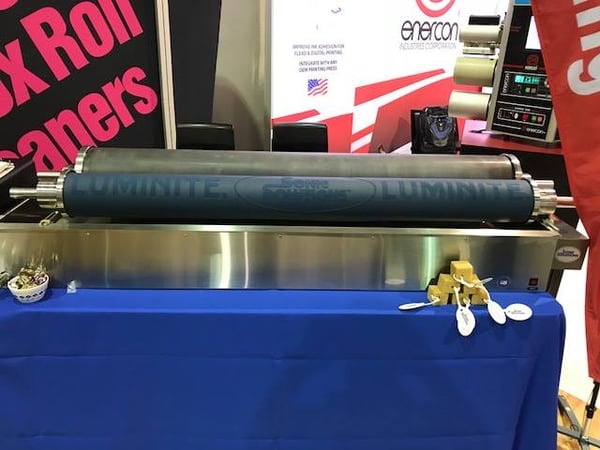Share this
How to Clean Your Flexographic Printing Products
by Luminite on Oct 4, 2018 4:26:01 PM

It might seem like cleaning your flexo printing products is just about as much fun as watching grass grow. Cleaning may seem like just another must-do chore, but doing it right can have a huge impact on how great your final product looks.
Dried ink, dust, and other contaminants often team up to create dirty prints that clients will not accept.
Learning how to clean your flexo materials is the first step to thwarting any potential printing defects.
Flexo Image Carrier Cleaning
According to packagePRINTING.com, proper image carrier cleaning practices can lead to better ink transfer and an increased lifespan for your image carrier.
Some of the most important points to understand when cleaning image carriers include:
Be Fast:
Clean the image carrier as soon as possible after the run, because ink starts to dry immediately and makes the job even harder as time goes by.
Be Gentle:
Don’t use a dirty rag, harsh abrasive, coarse brush, or pantyhose that can wear down the image carriers. Use something like a horsehair brush, lint-free rag or soft sponge.
Be Careful:
Depending on the type of ink and composition of the image carrier, the best cleaning solution is often just 100% alcohol, but it is always best to perform a quick swell test on a small section of the image carrier before attempting to clean the entire piece.
Be wary of using any “bargain” solutions or harsh chemicals that might end up causing damage to your expensive image carriers.
Cleaning the Anilox Rollers
Don’t just grab any solution that is nearby when it comes to cleaning anilox rollers.
You don’t want to damage the outer coating or sleeve, but still want to achieve a deep-cleaning so the roller continues to deliver the correct amount of ink. Here are some options used in cleaning anilox rollers:
Soda Blasting:
Air pressure blasts the roller with baking soda to clean it, with the residue sucked out via a vacuum unit.
Poly Beads:
Usually done off-press, these beads gently remove dried ink.
Enclosed Cleaning Systems:
Sonic Solutions provides an ultrasonic anilox roll cleaner that involves the use of high frequency sound vibrations to create a cleaning action.
The Flexo Maid system helps to prevents ink build-up, and lengthens the duration of the anilox.
Chemicals:
Chemicals such as sodium hydroxide or potassium hydroxide and stainless steel, brass or soft brushes may be used to manually remove dried ink, but they require more rinsing and a higher degree of safety precautions.
However, over time, these harsher cleaning methods can degrade the anilox and shorten its life span.
Other Cleaning Considerations
Let the individual pieces air dry and be sure to properly store your image carriers and anilox so they are ready for the next run.
Cleaning the Printing Press
Although the image carriers and anilox rollers are the two most crucial components to a quality print run, you want to keep the rest of your machine clean, lubricated and well-maintained as well so that it continues to function smoothly.
Don’t forget to check your CI Drum, or back-up roll, to make sure there is no dried ink residue or buildup that can affect your final print.
Keep the room and moving parts free of dirt that can get onto the printing components.
Although it might seem like cleaning takes away from quality production time, doing it properly can actually save you a lot of problems and headaches in the long run.
Have you tried all of the above steps, but your final prints are still coming out wrong?
The next step is to check out our Printing Defects Guide:
Share this
- Flexographic Printing (81)
- Image Carrier (28)
- Elastomer sleeves (27)
- Ink Transfer (25)
- Quality (22)
- Flexo sleeve (20)
- News (18)
- printing defects (18)
- flexo printing defects (17)
- sustainability (13)
- Flexo Troubleshooting (12)
- Ink (12)
- Digital Printing (10)
- Flexo 101 (10)
- Flexo Inks, (9)
- Anilox (7)
- Blister Packaging (7)
- Cost (6)
- print misregistration (6)
- regulations (6)
- Corrugated Printing (4)
- pinholing (4)
- "Tradeshow (3)
- Digital Flexo (3)
- Gravure Printing (3)
- Insider (3)
- Load-N-Lok (3)
- Wide Web (3)
- direct laser engraving (3)
- flexo-equipment-accessories (3)
- gear marks (3)
- halo (3)
- testing (3)
- Narrow Web (2)
- bridging (2)
- feathering (2)
- filling in (2)
- mottled image (2)
- pressure (2)
- Labelexpo (1)
- dirty prints (1)
- doughnuts (1)
- embossing (1)
- kiss impression (1)
- October 2023 (2)
- September 2023 (1)
- August 2023 (1)
- July 2023 (3)
- June 2023 (1)
- May 2023 (5)
- April 2023 (1)
- March 2023 (2)
- February 2023 (1)
- January 2023 (3)
- December 2022 (1)
- October 2022 (3)
- September 2022 (2)
- August 2022 (2)
- July 2022 (3)
- May 2022 (1)
- April 2022 (4)
- March 2022 (2)
- February 2022 (5)
- January 2022 (7)
- December 2021 (1)
- November 2021 (3)
- October 2021 (2)
- September 2021 (1)
- August 2021 (1)
- July 2021 (3)
- June 2021 (1)
- May 2021 (4)
- April 2021 (4)
- March 2021 (4)
- February 2021 (2)
- December 2020 (1)
- November 2020 (1)
- October 2020 (2)
- September 2020 (1)
- August 2020 (3)
- July 2020 (2)
- June 2020 (3)
- May 2020 (1)
- April 2020 (1)
- November 2019 (3)
- October 2019 (1)
- August 2019 (1)
- July 2019 (1)
- April 2019 (1)
- March 2019 (1)
- January 2019 (1)
- October 2018 (2)
- August 2018 (1)
- July 2018 (1)
- June 2018 (1)
- February 2018 (2)
- October 2017 (1)
- September 2017 (2)
- January 2016 (1)
- February 2015 (1)
- January 2015 (1)
- December 2014 (2)
- September 2014 (1)
- February 2014 (1)
- January 2014 (1)
- December 2013 (3)
- October 2013 (1)
- September 2013 (1)
- June 2013 (1)
- January 2013 (1)


No Comments Yet
Let us know what you think